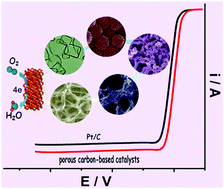Highly efficient nonprecious metal catalysts towards oxygen reduction reaction based on three-dimensional porous carbon nanostructures
Abstract
Developing a low cost, highly active, durable cathode towards an oxygen reduction reaction (ORR) is one of the high-priority research directions for commercialization of low-temperature polymer electrolyte membrane fuel cells (PEMFCs). However, the electrochemical performance of PEMFCs is still hindered by the high cost and insufficient durability of the traditional Pt-based cathode catalysts. Under these circumstances, the search for efficient alternatives to replace Pt for constructing highly efficient nonprecious metal catalysts (NPMCs) has been growing intensively and has received great interest. Combining with the compositional effects, the accurate design of NPMCs with 3D porous nanostructures plays a significant role in further enhancing ORR performance. These 3D porous architectures are able to provide higher specific surface areas and larger pore volumes, not only maximizing the availability of electron transfer within the nanosized electrocatalyst surface area but also providing better mass transport of reactants to the electrocatalyst. In this Tutorial Review, we focus on the rational design and synthesis of different 3D porous carbon-based nanomaterials, such as heteroatom-doped carbon, metal–nitrogen–carbon nanostructures and a series of carbon/nonprecious metal-based hybrids. More importantly, their enhanced ORR performances are also demonstrated by virtue of their favorably porous morphologies and compositional effects. Finally, the future trends and perspectives for the highly efficient porous NPMCs regarding the material design are discussed, with an emphasis on substantial development of advanced carbon-based NPMCs for ORR in the near future.


 Please wait while we load your content...
Please wait while we load your content...